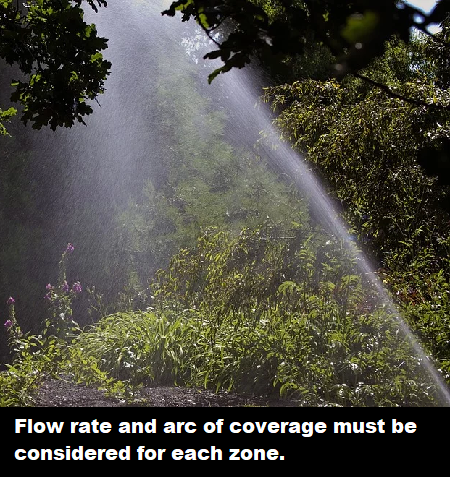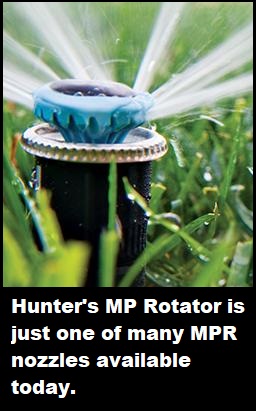Matched Precipitation Rates Prevent
Runoff and Dry Spots
As an irrigation professional, you know how important water efficiency has become to the industry.
Gone are the days of sprinkler run-off overflowing into the street. With today’s technology — smart controllers, rotary nozzles, soil moisture sensors, etc. — the irrigation industry is using water much more efficiently than ever before.
And one key to that water efficiency is matched precipitation.
The Basics
When designing sprinkler systems, matching precipitation rates can help to avoid wet and dry spots, as well as excessive run times. Which is why irrigation system designers must consider flow rates and arcs of coverage to ensure even precipitation for each coverage area or zone.

Pixabay Image
Flow rates are proportional to the degree of arc covered. For example, the flow rate of a quarter-circle (90⁰) sprinkler head is equal to one-quarter that of a full-circle (360⁰) head. Likewise, the flow rate of a half-circle (180⁰) spray is equal to one-half that of a full circle.
Matched precipitation rate can be achieved two ways:
- By zoning together sprinklers with the same precipitation rate (Gallons Per Minute x 96.3 ÷ area), or
- By selecting the appropriate Matched Precipitation Rate (MPR) nozzles.
Note: Spray and multi-stream rotary heads automatically match precipitation; single-stream rotors do not.
Zoning Together
When heads without matched precipitation rates are used in the same zone, dry spots often develop. This can lead to the extension of sprinkler run times, as the entire area is watered longer to keep the dry spot alive. That’s why it’s important to always zone together sprinkler heads with the same precipitation rate.
This can be achieved by matching the gallons per minute (GPM) of a standard rotor to its arc and reducing the range accordingly. For example, two GPM at 90⁰ would equal four GPM at 180⁰, or eight GPM if the sprinkler head covers a full circle.
An Illustration
The Hunter Industries website offers the following illustration of three different sprinkler heads with matched precipitation rates:
Hunter Industries Image
For each of these sprinkler heads, one GPM is applied to each quarter circle (assuming the throw radius is the same for each head). As a result, precipitation is matched.
On the other hand, if you were to install nozzles with the same flow rate on all three heads, areas covered by the 90⁰ head would receive four times as much water as the area covered by the full-circle head. So the quarter-circle area would flood long before areas covered by the 360⁰ head received sufficient water.
(For detailed examples of how this works, click here.)
MPR Nozzles

Hunter Industries Photo
Matched Precipitation Rate (MPR) nozzles provide a much simpler way to match precipitation rates within the respective irrigation zones. These nozzles allow sprinklers with various arcs and radii to be mixed on the same circuit. They work well, for example, with beds or turf areas that are irregularly shaped and therefore require varying radii of sprinkler heads within the same zone.
MPR nozzles offer irrigation contractors and technicians greater flexibility when working on the system. Different nozzles can be used for precise watering, while still maintaining matched precipitation rates across the irrigation zone.
Can You Mix and Still Match?
So can different types of sprinklers be used within the same zones? According to Brent Barkley, product manager for Rain Bird in Azusa, Calif., the answer is “Yes, but cautiously.”
“With careful design, and the right products, it is possible to match the precipitation rates of rotors and rotary nozzles, allowing them to be zoned together while irrigating different sections of an irregularly shaped lawn,” said Barkley. An example would be if rotors are being used on a fairly large area of turf in a front lawn, you could probably utilize some rotary nozzles to irrigate a narrow strip of side yard.
What you want to avoid, however, is a hodgepodge (“crazy quilt”) of sprinkler types with no apparent rhyme or reason. A situation like that can result when numerous repairs and alterations are performed by various contractors over the years.
Particularly on older systems, you may see the crazy quilt layout, with a combination of spray heads and rotors delivering water at much different precipitation rates. In such a situation, replacing the spray heads with rotary nozzles can help come very close to achieving matched precipitation rates without replacing the whole system.
Sources:
Featured Image: Adobe, License Granted
Hunter Industries
Irrigation & Green Industry
Irrigation Toolbox







Trackbacks/Pingbacks